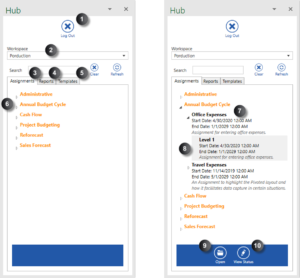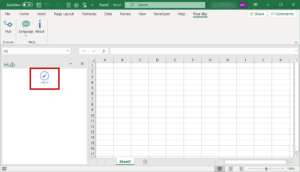On this page:
The following screen capture highlights the main menu elements found within the True Sky Ribbon Bar as seen by an End User prior to retrieval of an Assignment or Report.
NOTE: The examples shown below utilize Office 365, the icons might have a slightly different look and feel when using other releases of Excel.

True Sky Ribbon Bar Before Opening an Assignment or Report
The next screen capture highlights the menu elements found within the True Sky Ribbon Bar as seen by an End User after opening an Assignment or Report. Please keep in mind that individual buttons may or may not be available (greyed out) depending on the specific parameters of the Assignment or Report that has been opened.

True Sky Ribbon Bar After Opening an Assignment or Report
More detailed explanations of each of these functions can be found throughout this manual.
Reports and Assignments allow you to view and/or enter data through an easy-to-use Excel presentation layer. True Sky allows a Template Designer to use Excel to create a single Template that can then be published and utilized by multiple users simultaneously.
Once a Template has been created, a True Sky Administrator than takes this Template and combines it with a Security Group and an Approval Tree to create either an Assignment or a Report. Assignments allow for data input and approval, while Reports are locked down in read-only mode. When you open an Assignment or Report from within the True Sky Hub, you receive a unique copy of the Template that has been dynamically formatted for you.
While working with Assignments and Reports you have the ability to leverage almost every feature found within Excel including conditional formatting and most importantly the vast array of formulas and functions for which Excel is known. Since both Assignments and Reports leverage the same feature sets, this eliminates the need for you to learn two different tools. However, certain features are only available to Assignments and not Reports. The differences are highlighted in the following table:
| Feature/Function | Assignments | Reports |
| Retrieve Data from Database | Yes | Yes |
| Filter Data Retrieved | Yes | Yes |
| View Existing Data | Yes | Yes |
| Add New Data | Yes | No |
| Edit Existing Data | Yes | No |
| Delete Existing Data | Yes | No |
| Submit Data for Approval | Yes | No |
| Approve/Reject Submitted Data | Yes | No |
| Run Validations on Data | Yes | Yes |
| View Existing Notes/Attachments | Yes | Yes |
| Add New Notes/Attachments | Yes | Yes |
| View Audit Trails | Yes | Yes |
| Copy Prior Entered Data to Current | Yes | No |
| Access Data Manipulation Tools | Yes | No |
| View Indicators | Yes | Yes |
| Access Links Function | Yes | Yes |
| Access Routines Function | Yes | Yes |
| Suppress Nulls/Zeros | Yes | Yes |
| Add New Worksheet | Yes | Yes |
| Delete Existing Worksheet | Yes | Yes |
| View Existing Detail Lines | Yes | Yes |
| Add New Detail Lines | Yes | No |
| Edit Existing Detail Lines | Yes | No |
| Delete Existing Detail Lines | Yes | No |
| Change User Interface Language | Yes | Yes |
Assignments and Reports are accessed via the Hub. Pressing the “Hub” button from the Ribbon Bar will open the Hub pane. The Hub displays the Assignments and Reports that you have access to within True Sky. The items shown are unique to you based on your role within True Sky, your security settings and other system configuration options.
The elements that comprise the Hub are presented in the list and screenshots to follow:

True Sky Hub on Initial Open & Hub Showing Assignment and Assignment Level
True Sky can be configured to either support single sign-on via Windows Active Directory or forms-based authentication. Single sign-on “passes” the username and password you entered to access your computer to True Sky and uses that to authenticate you as an authorized user. Forms-based authentication requires a user to enter a username and password in order to log onto True Sky. This username is set by a True Sky Administrator and may or may not be the same as your network login. Once your account is created in True Sky, you will receive an email with password reset instructions.
NOTE: If your organization is utilizing True Sky Online (True Sky in the “cloud”) then forms-based authentication is the only supported authentication method.
NOTE: All passwords must be strong passwords, at least 8 characters long, with at least one upper-case character, one lower-case character, one number and one special character. How long passwords may be cached to prevent reentry is determined by the True Sky Administrator.
NOTE: Three incorrect passwords in a row will result in your account being locked and it will need to be unlocked by an Administrator before you can access True Sky again.

Forms-Based Authentication Screen Upon Initial Open
True Sky supports multiple regional formats for the user interface. For example, in North America numbers are traditionally expressed using a comma as the thousand’s separator and a period as the decimal indicator. However, in France, thousands are typically separated using a blank space and a comma as the decimal indicator and in Germany, a period is used as the thousand’s separator and a comma as the decimal indicator. True Sky automatically detects which regional format that your copy of Windows is using and adjusts automatically when the user saves or retrieves data. All data is saved in the SQL Server default North American format.
True Sky also supports multiple language formats for the user interface. Currently supported formats are English (US), English (Canada), French (France), French (Canada) and Spanish (Espana). True Sky will automatically default the interface to your installed language version of Windows, but you can change the interface at any time by making a different selection from clicking “Language” button in the True Sky Ribbon Bar.

Language Selection Button

Selecting a language

True Sky Ribbon Bar in French
It is important to remember that True Sky does not save any user inputted information in the Excel Worksheet. Excel is the presentation and user interface layer and all data saved is stored in a centralized database.
True Sky Template Designers have the ability to create Templates that are unique to your organization and your corporate performance management needs. The color, shading, fonts and layouts used are determined by your Template Designer. Therefore, the Assignments and Reports you interact with will most likely look different from the examples show in this manual. In addition, buttons, colors, windows and icons may look slightly different given the version of Excel you are using.